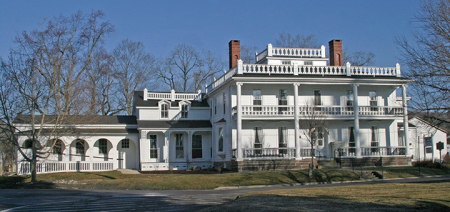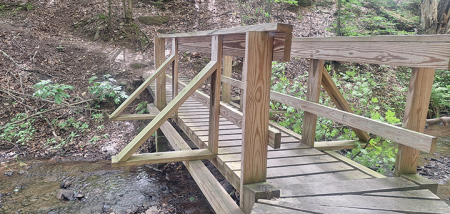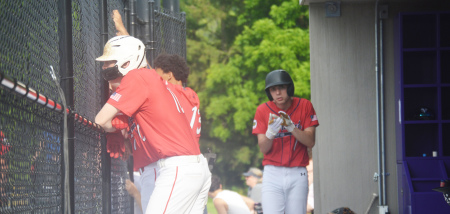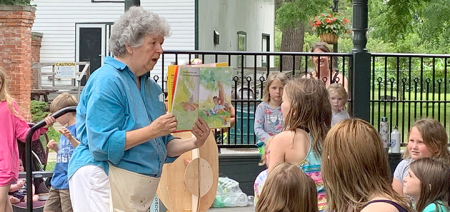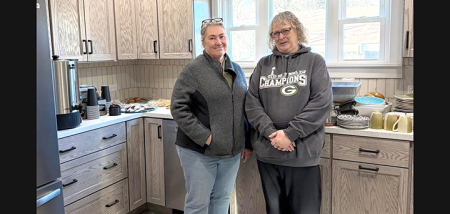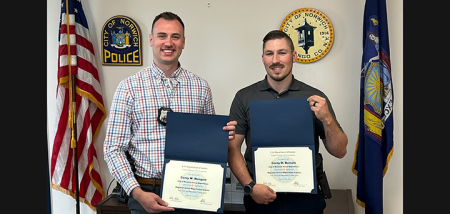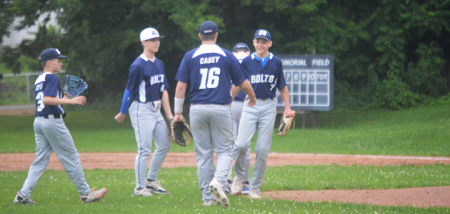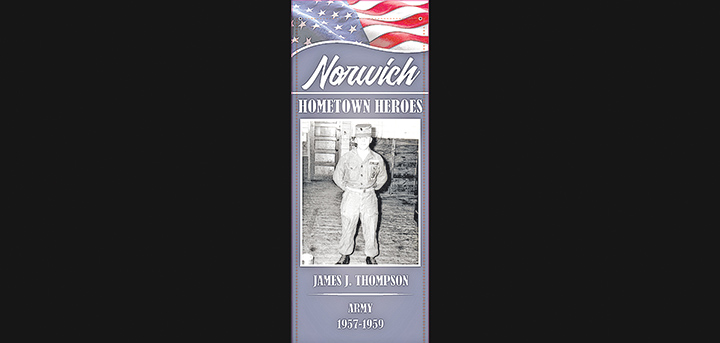Walling's Maple Syrup: It All Starts With The Sap
Published:
February 22nd, 2023
By:
Kelli Miller
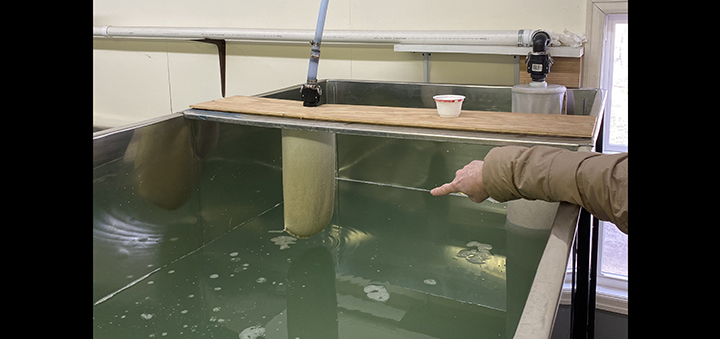 Kern Walling points to the sap water in large holding tank. (Photo by Kelli Miller)
Kern Walling points to the sap water in large holding tank. (Photo by Kelli Miller)
SOUTH NEW BERLIN — Kern and Sue Walling have been making maple syrup for over 30 years in South New Berlin.
Walling's Maple Syrup Farm is family owned and operated, and they take great pride in making certified organic maple syrup and products.
They are members of the New York State Maple Producer's Association. In 2017, they were certified Organic by Baystate Organic Certifiers (BOC). BOC status lets everyone know the product is free of pesticides and anything synthetic.
The Wallings see each and every process from beginning to end. They have up to 40 miles of tubing, which are on a vacuum system. It's important to check tubing daily, ensuring all lines are up and running. They utilize valves to check the lines throughout, turning them on and off to find if any lines are down.
Fallen trees, porcupines, raccoons, and fishers create chew marks and sometimes chew all the way through the tubes. Insects and bugs can also create havoc: The damage done can delay hours in daily production. The most important thing during sugar season is to keep all vacuums up and running.
Sue said, “Over the years, through communicating with the public, I've come to realize that a lot of people believe maple syrup flows right out of the tree, ready to pour over pancakes. If not educated, how would they know? The fact is, maple syrup has an entire cooking process to go through. It all starts with the sap.”
Sap is a semi-clear, slightly sweet liquid known as maple water. It is a thin substance that is approximately 98 percent water and 2 percent sugar. Maple trees release their sap when the temperatures outside are above freezing.
“The acrylic spouts used for tapping maple trees are much smaller in diameter than previous antique wooden hand-carved spouts. A long time ago, they would just drill holes about the size of their finger and place the larger spouts inside the holes. These larger holes took a long time to heal and scars could visibly be seen on the bark," said Kern. "Now, with plenty of research, newer, smaller spouts are being used, thus creating a sustainable life for the tree. The trees heal faster and the drilled holes grow over quickly. You can hardly even see where they've been tapped. Two taps in a larger tree is acceptable but you want to make sure not to tap a young tree.”
“When you tap a tree, you drill a small hole and place the acrylic spout in about to where the little ball is in the spout. At the end of the spout you add the tubing. The tubing then is added to the main line which has a slight vacuum. The lines are connected from tree to tree and carry the sugar water to outside canisters that dump into a holding tank. Then the sugar water is pumped in overhead lines, directly to the sugar house. We do not use buckets anymore but did back in the day. We upgraded to our new system over the years,” he continued.
“Inside the sugar house, the sap is dumped from overhead lines into a large holding tank. From the larger indoor tank the sap is then fed through the reverse osmosis machine. Most of the water is taken from the sap using this machine. Out of 10,000 gallons of sap, 9,000 gallons of water is removed. So, we only boil 1,000 gallons of high sugar solution. Without this system we couldn’t boil as quickly. We used to boil from morning to night, all night long,” Sue added.
“All of the water that comes out of the sugar solution is saved and used to go back through the machines to clean them. We don’t have to use well water. This is great water to use because it takes all of the minerals out of the machines and eats the sugar sand. We use it to clean everything. About 3,000 gallons is used for that and also [to] clean pans. We clean every time we concentrate the sap,” Kern said.
“When we're ready to boil, Kern turns valves and lets some of the sap come through the pipes to the back evaporator. It feeds a little bit at at a time, drips down, and most of the evaporating takes place in the back pan. It draws constantly as we get going. As it boils, it becomes thicker and thicker, flowing through the entire machine. Like a little maze, each section has a triangle cut out of each corner of the divider, allowing the flow. The more its in the machine, the stronger it becomes. Every night is different because the pressure is different,” Sue said.
“After the syrup has made its way through the evaporator its pumped into a smaller syrup tank. The syrup stays there with lit burners underneath to keep it warm enough so that when we get it full, we send the syrup through the filter press. The filter press removes any impurities that may be in the syrup: bugs or pine needles. Then we pump the syrup into steel drums where it stays until we're ready to bottle it up and sell to people.
“All the while, the sweet maple smell fills the air outside when we're processing. It's hard to describe the smell but when its windy, it blows around and fills the air with pure sweetness,” Sue added.
“When the sap is really flowing fast, we get up between 2 a.m. to 4 a.m. Those days we're up for three to four days in a row, sometimes we boil two times a day. A couple times a year we are in survival mode,” Kern said. “We don’t sleep much at that time.”
“The true beginning of sap season depends on the weather. Global warming or whatever you want to call it, warmer weather, has changed the drill time to now drill in mid-December, about the 15th and be pretty much done in middle-March, instead of May,” Kern said.
“In the beginning of the season you may get two percent sugar, but by the end about one percent. Sap gets sour at the end of the season when the trees want to grow leaves. Buds come on and the syrup is light colored. Most syrup makers call it 'Bud Light,'" Sue said.
She added, “Years ago, when we cooked our first batch, I had a lot of kids to take care of and diapers kept me busy. It was a crazy time. The batch was cooked outside on an open fire. Kern and our son Tony stood outside over the boiling sap, during a rain and snow storm while the rest of us were inside, looking out the window."
"It was because of our son Tony we started making maple syrup. He helped the farmer up the way with his syrup and wanted to try it at home. He was 11 at the time. Soon he tapped a few trees on his own and hung jugs and boiled in the kitchen. That is when we decided to build the sugar house," she continued.
“Tapping was a little over halfway complete in early January this year. As we walked the property, we approached a big, soft maple that previously split but continued to grow side by side, and inside we discovered a group of denning porcupines. In case you didn't know, a group of porcupines is called a prickle.”
The Sugar House store is right next to their house. There are no set hours; Regular customers come in and flip on lights to self serve, and a book is there to write down what you need.
“We're pretty informal. People get what they want. Kind of neat really,” Kern said.
Sue said, “Our inventory includes certified organic products such as maple syrup in plastic jugs and glass bottles, granulated maple sugar, maple cream, molded maple sugar, maple coated peanuts, maple popcorn, black maple tea, herbal maple tea, and a few t-shirts with the saying, "'I'd tap that.'"
She added, “We've given tours to girl scouts and classes from schools, or when people stop on their way to somewhere else, I'll just show them around. It's what we do.”
Walling’s Maple Syrup and products can be shipped anywhere in the US Via USPS. Their products can also be purchased at Norwich Copies Plus, the Norwich Farmers' Market, Seasons Gift shop in Norwich, the Binghamton Welcome Center, and The Taste of New York.
You can email the Wallings at wallingsmaplesyrup@gmail.com or you can call 607-334-2711.
Author: Kelli Miller - More From This Author
Comments

